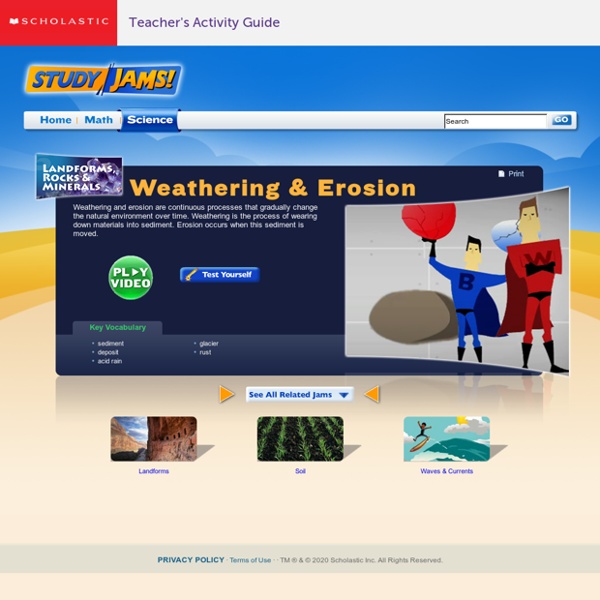



Lessons - Breaking it Down - Lesson Activities | Nature 1. Have students log on to the interactive game “Shape It Up!” Explain that this game will challenge them to identify the forces that shape the earth’s surface and the relative speed with which they act. After explaining that “erosion” is generally a process whereby the earth’s surface is worn down, provide students with a FOCUS FOR MEDIA INTERACTION by asking them to determine which of the game’s four earth-shaping forces (wind, water, glacial and volcanic activity) is NOT a force of erosion. Allow students to play the game for approximately 5 minutes-enough time for everyone to have played every scenario in the game. 2. 3. 1. 2. 3. 4. 5. 6. 1. 2. Divide the class into groups of 4-5 students. 3. 4. 5. 6. 7. 8. 9. 1. 2. 1. 2. 3. PLAY Clip 1, “Hawaiian Coastal Cliffs” (access the video segments for this lesson at the Video Segments Page). 4. 5. PLAY Clip 2, “Water Erosion” (access the video segments for this lesson at the Video Segments Page). 6. 7. 9. 1. 2. History Chemistry
Weather Wiz Kids weather information for kids 13 Colonies Trades and Artisans « Cooper Coopers were tradesman who made casks, buckets, barrels, and containers for flour, gunpowder, tobacco, shipping, wine, milk, and other liquids. One kind of container, the hogshead, was used to ship huge quantities of tobacco from the colonies to England. Because the demand for containers was high, colonial coopers made millions of such containers every year. The construction of a barrel (more accurately called a cask) took skill, experience, and significant manual labor. The word cooper comes from the Middle English word “couper,” which means tub or container.
Little Bird Tales - Home Children's Engineering A Note from CEE About K-5 Design Briefs Visitors to our site should be aware that there is more than one way to write K-5 design briefs. Much of what we have learned is through actually working with children in classrooms. Many of the design briefs posted on this page use the following format: Background statement Challenge statement Criteria What can you use? As years went by we made adjustments to the formats we use when writing design briefs. Why did we think a change was important? We now prefer the following format for writing design briefs. Background statement Challenge statement Criteria Materials Tools Keep smiling and keep visiting!
Enchanted Learning - Member Login Enchanted Learning Login Hints:Your username and password are case-sensitive. Make sure that your CAPS LOCK key is not on. Be careful to type UPPER- and lower-case letters as needed. Do not type extra spaces or other characters. Not a member yet? You can check out our fun educational content at the Enchanted Learning site for non-members before you become a site member. If you do not receive an answer from us within a few hours, your email is probably not working properly (a typo, a full mailbox, an overactive spam filter, or you're not accepting email from us). Click here for our privacy policy Copyright ©2001 EnchantedLearning.com ------ How to cite a web page
3rd Grade Thoughts This post is all about yet another reason why I love the teacher blogging world! While browsing on Pinterest all summer, I came across a very cool program: 7 Habits of Happy Kids. I instantly fell in love, especially with the very first habit of "Being Proactive"-- aaah, music to my teacher ears! This program is under the larger umbrella of Leader in Me and was developed my the Coveys (of 7 Habits of Highly Effective People fame). The 7 Habits of Happy Kids are: Be proactiveBegin with the end in mindPut first things firstThink win-winSeek first to understand, then to be understoodSynergizeSharpen the saw Some of these may seem a bit odd at first, but the great thing is that each of them come with a tagline and also countless bullet points and descriptors that help kids (and teachers) address the many aspects of each habit. These are available for FREE on Google Docs. But, of course, the BESTEST of all resources come from teachers in blogland and TpT :)